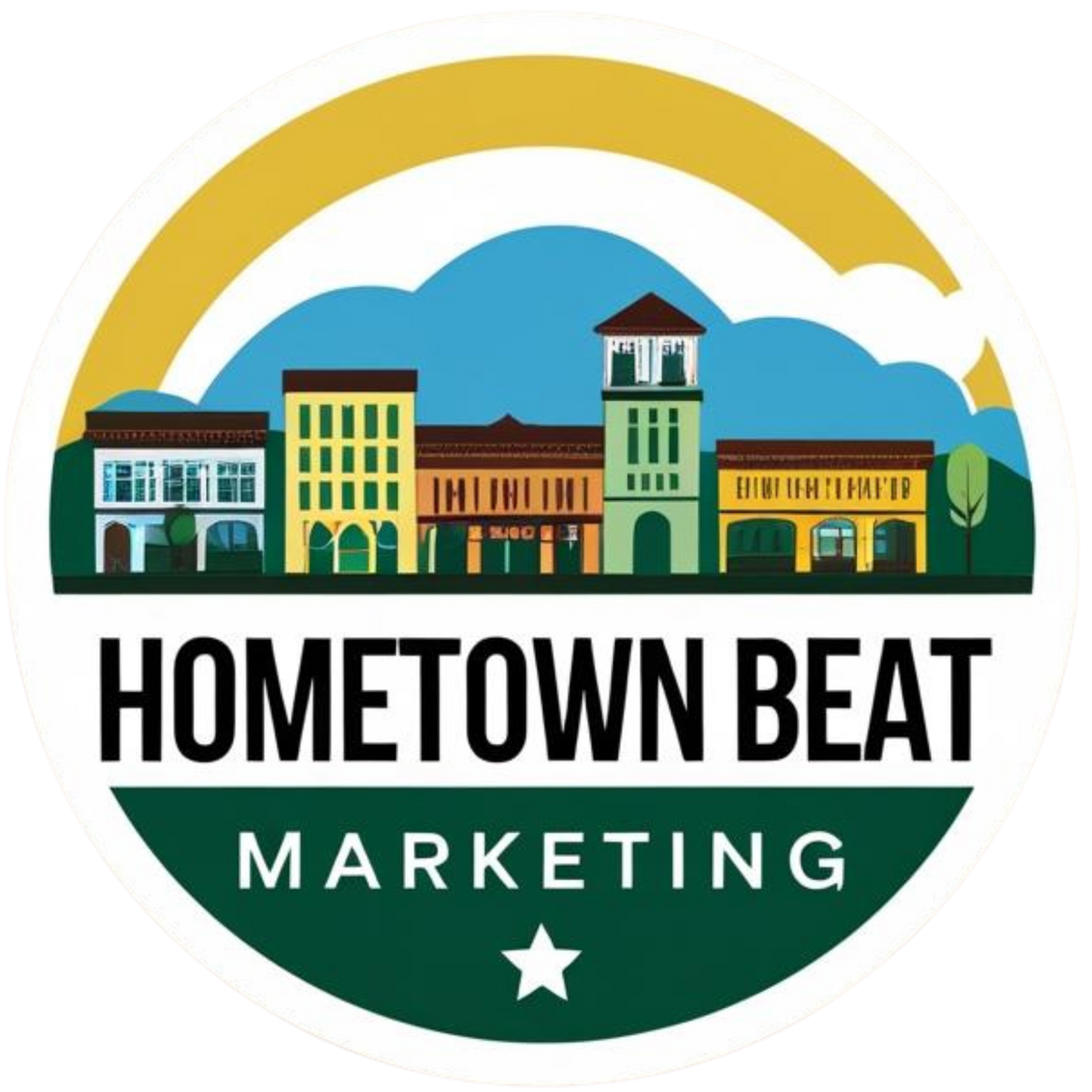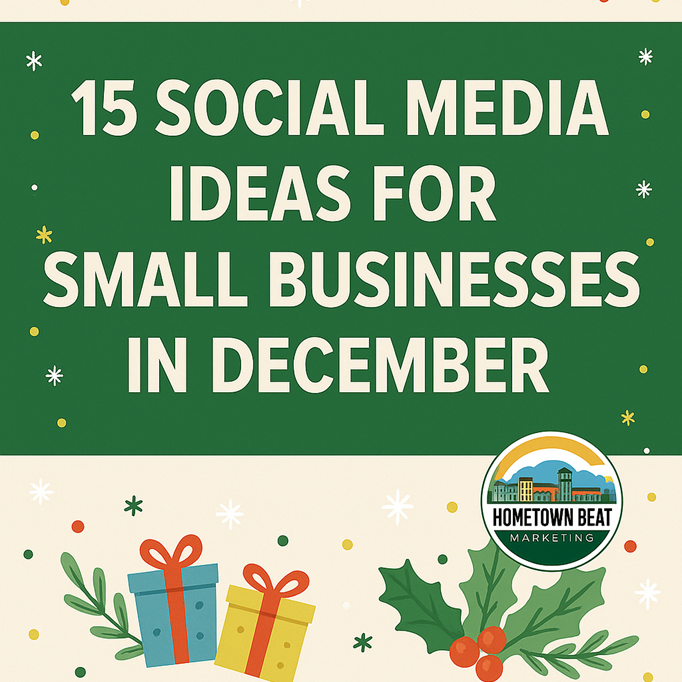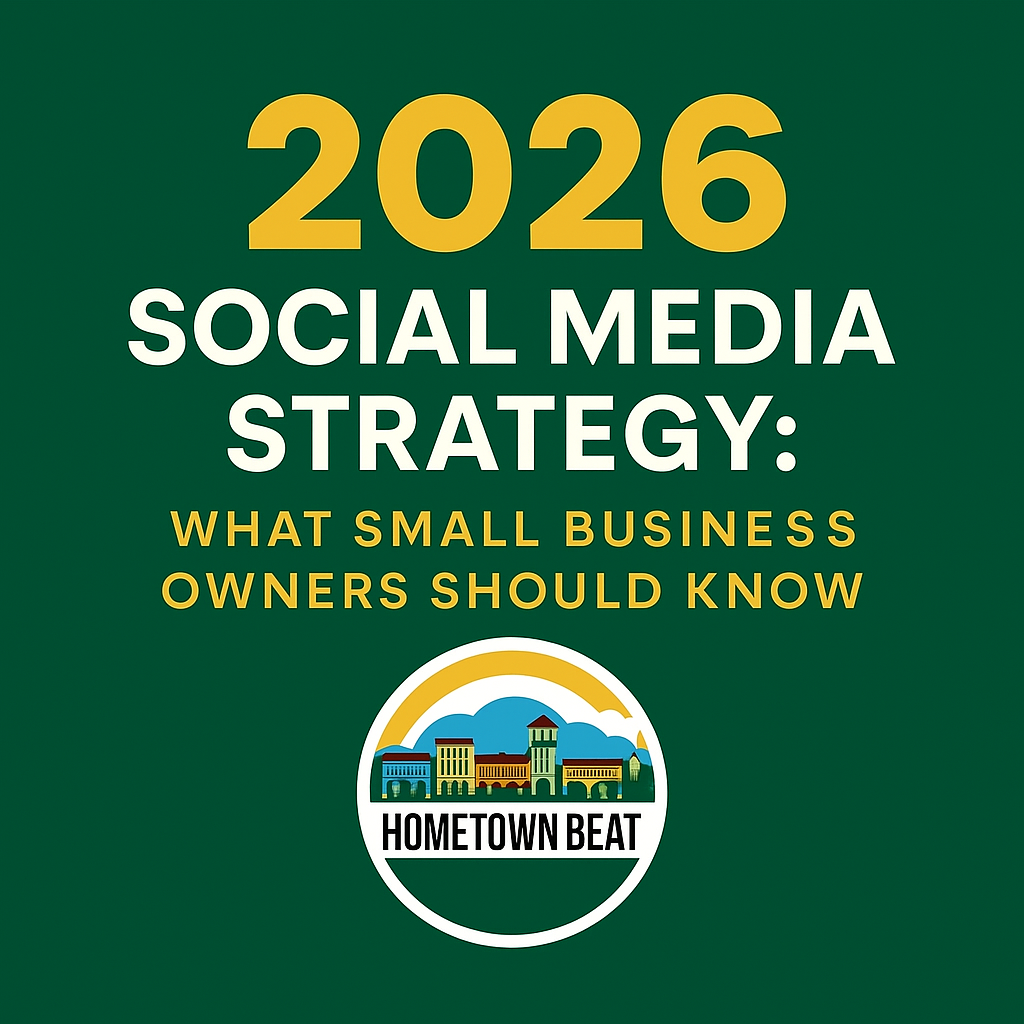How AI is reshaping SEO: Challenges, opportunities, and brand strategies for 2025


The cyclical, now AI-fueled, “ SEO is dead” panic cycle is in full swing.
But here’s what most of those headlines miss:
Search isn’t a platform, it’s a behavior.



Whether people are typing into Google or prompting ChatGPT, consumers are still asking questions that require content, expertise, and trust.
Search isn’t dying – it’s fracturing – as it always has when new platforms emerge and achieve mainstream adoption.
Fortunately, generative engine optimization (GEO) is based on similar value systems that advanced SEOs, content marketers, and digital PR teams are already experts in.
The entity authority framework
- Media mentions across trusted publications.
- Schema-enriched pages with structured data.
- First-party research that establishes expertise.
- Expert quotes and branded citations.
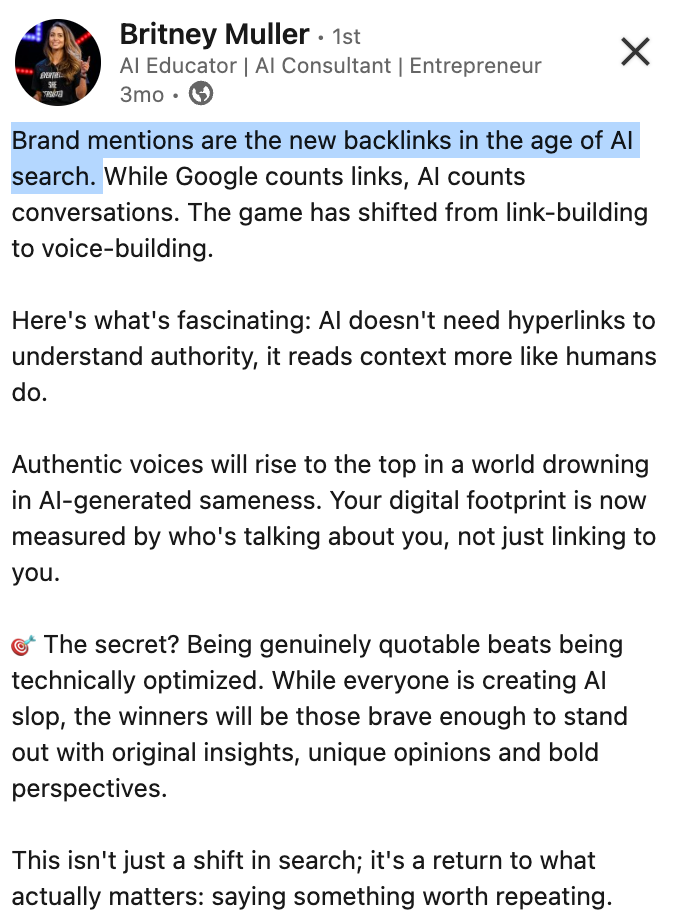
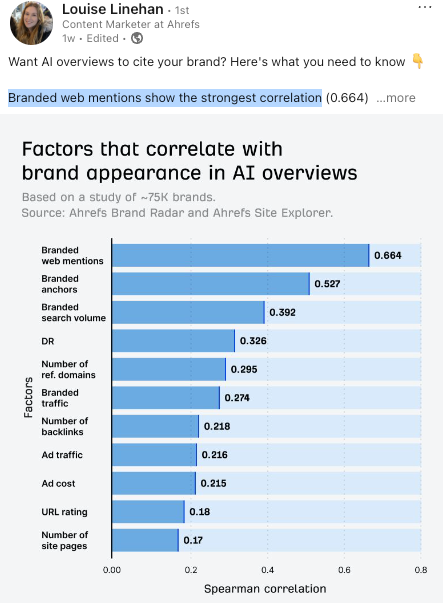
While AI will radically change consumer search behavior over the next few years, it’s relying on a lot of the same signals Google’s been rewarding for over a decade.
To maintain brand visibility as search fractures, brands need unified content and authority-building strategies that drive brand visibility across the multiple platforms where your target market resides:
- Indexable web content (for Google and Bing), schema markup for context, E-A-A-T signals and author bios, fresh data-driven insights
- Structured data and mentions (for LLMs and GEO), expert quotes in trade publications, first-party research citations, brand mentions across authoritative sites
- Short-form social content (for TikTok and Reels), searchable captions and hashtags, video content optimized for discovery, cross-platform content threading
Beyond algorithms, I wanted to understand how AI was influencing consumer search behavior and how marketers were adapting their strategies with these transformative workflow tools.
At SMX Advanced 2025 , I presented a cobranded study I led between Fractl Agents, Search Engine Land, and MFour that demonstrates:
- How consumers are shifting toward AI-powered search.
- How their trust in AI content is evolving.
- How marketers are leveraging AI to optimize workflows while maintaining brand credibility.

What follows is an actionable playbook built around the key takeaways from our research.
Consider this your guide to future-proofing your brand visibility and workflow efficiencies in the age of AI.
1. Two-thirds of consumers think AI will replace search in the next five years
But, AI chatbots only represent 2.96% of search engine traffic, currently.
This contradiction reveals the deeper truth: we’re in a paradigm shift of consumer search behavior, not an SEO extinction event.
Consumers are experimenting with new tools like ChatGPT, but they’re still heavily reliant on traditional search engines for the majority of their queries.
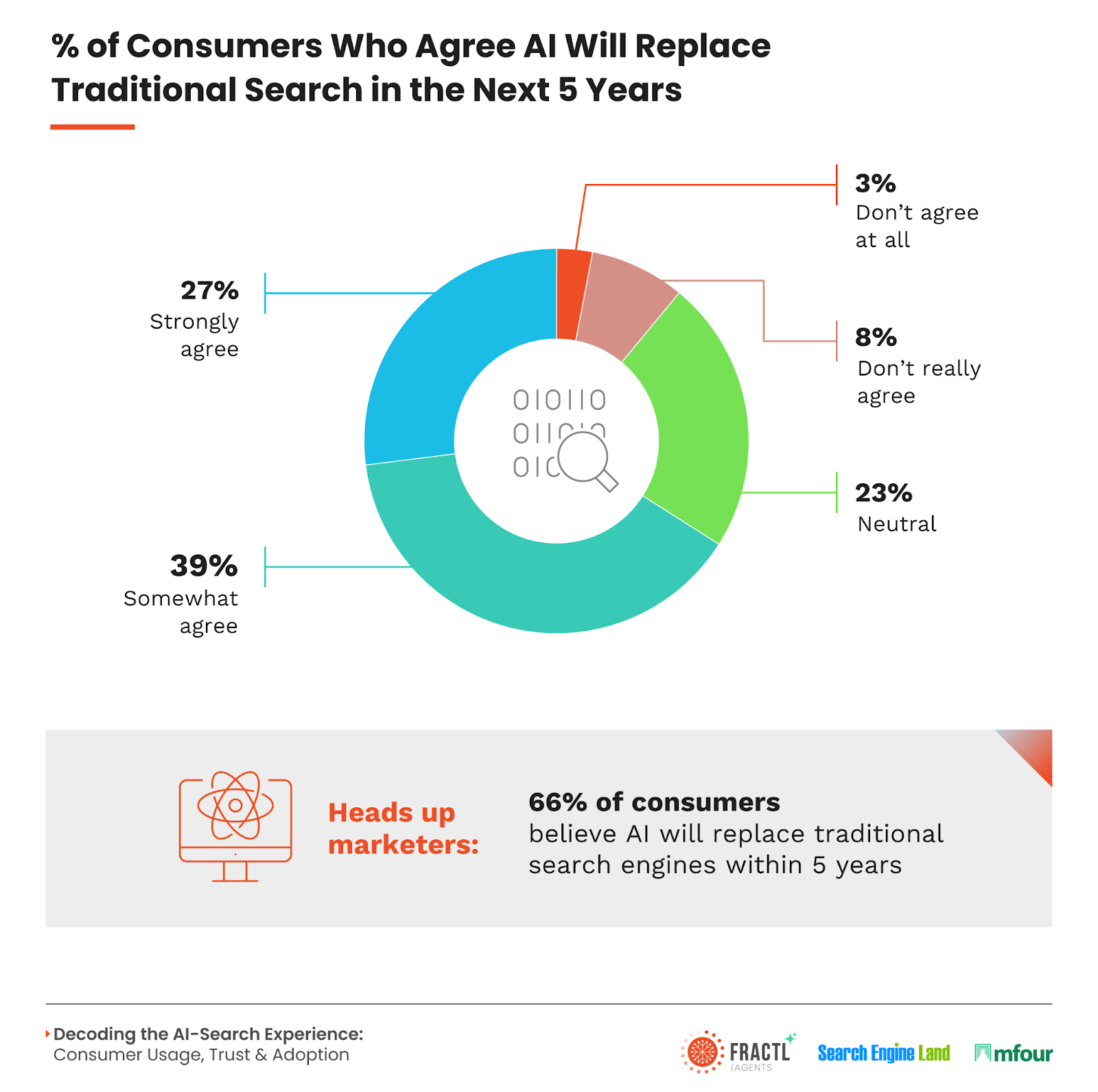
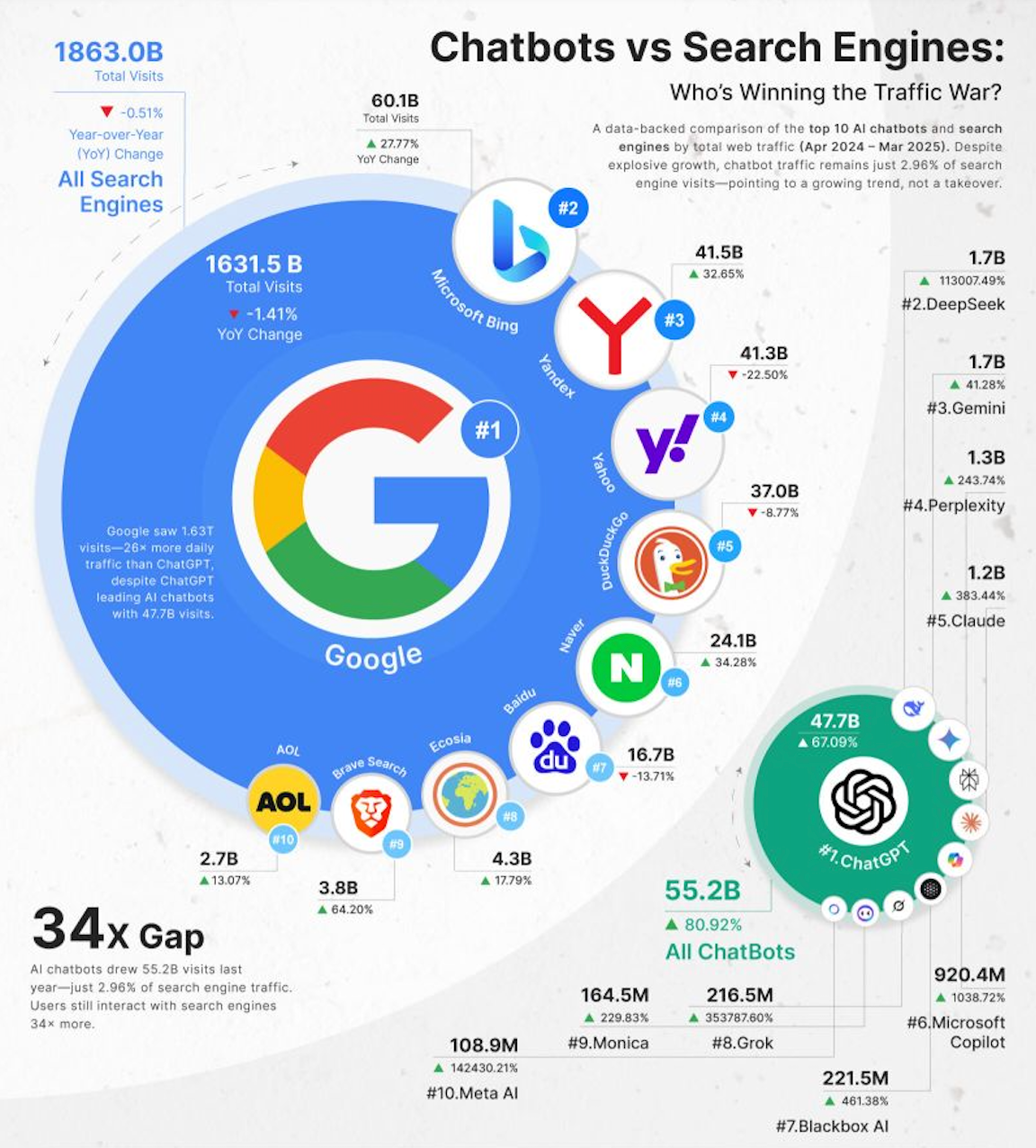
The consumer data tells a story that most headlines miss.
People are experimenting with AI-powered search, but 49% of them are still clicking the little blue link for deeper dives.
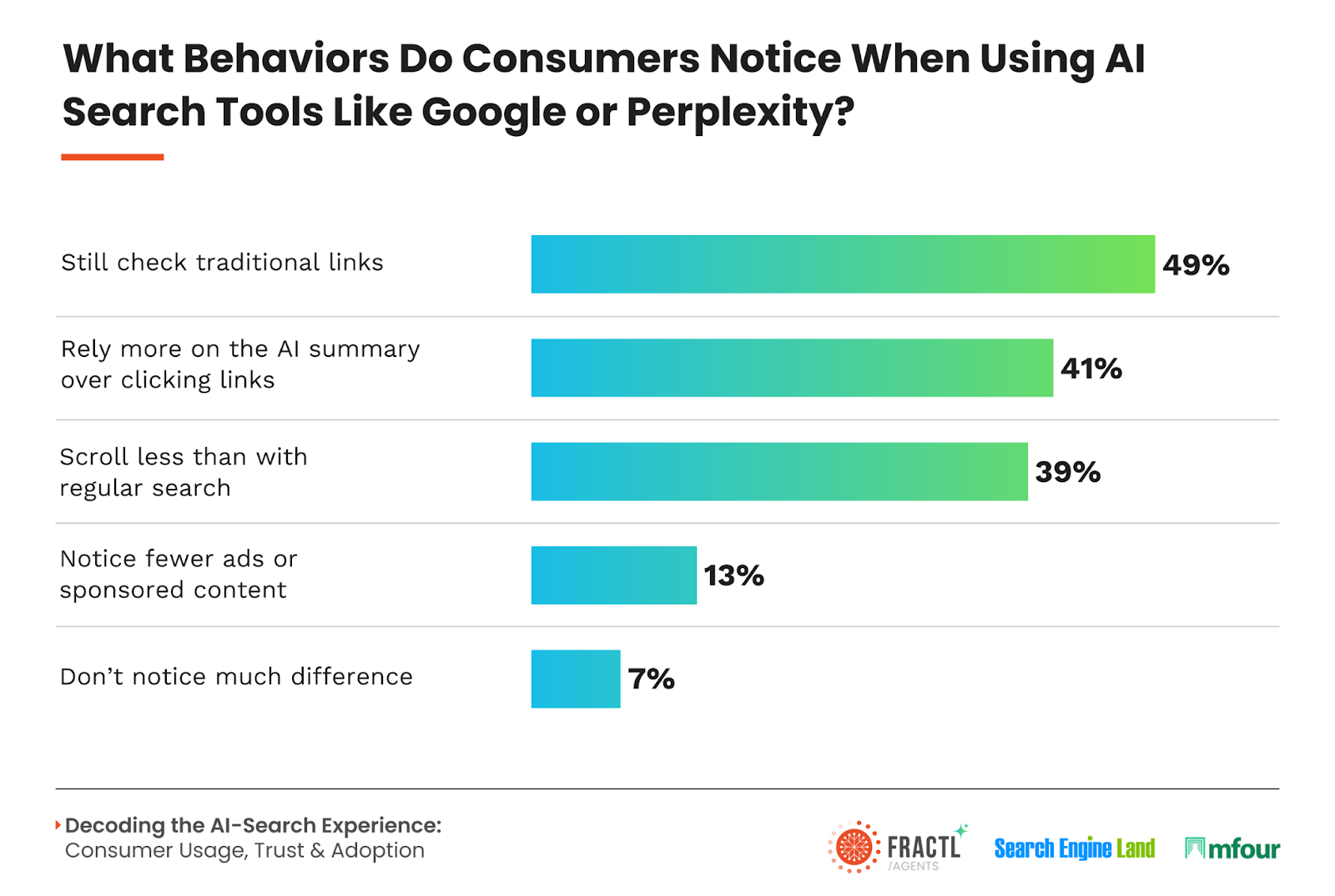
Nonetheless, friction and innovation drive adoption, and users have been increasingly frustrated with Google’s search experience.
In my February 2025 study, users cited ads cluttering search results, inaccurate AI Overviews , and irrelevant results as major friction points in traditional search.
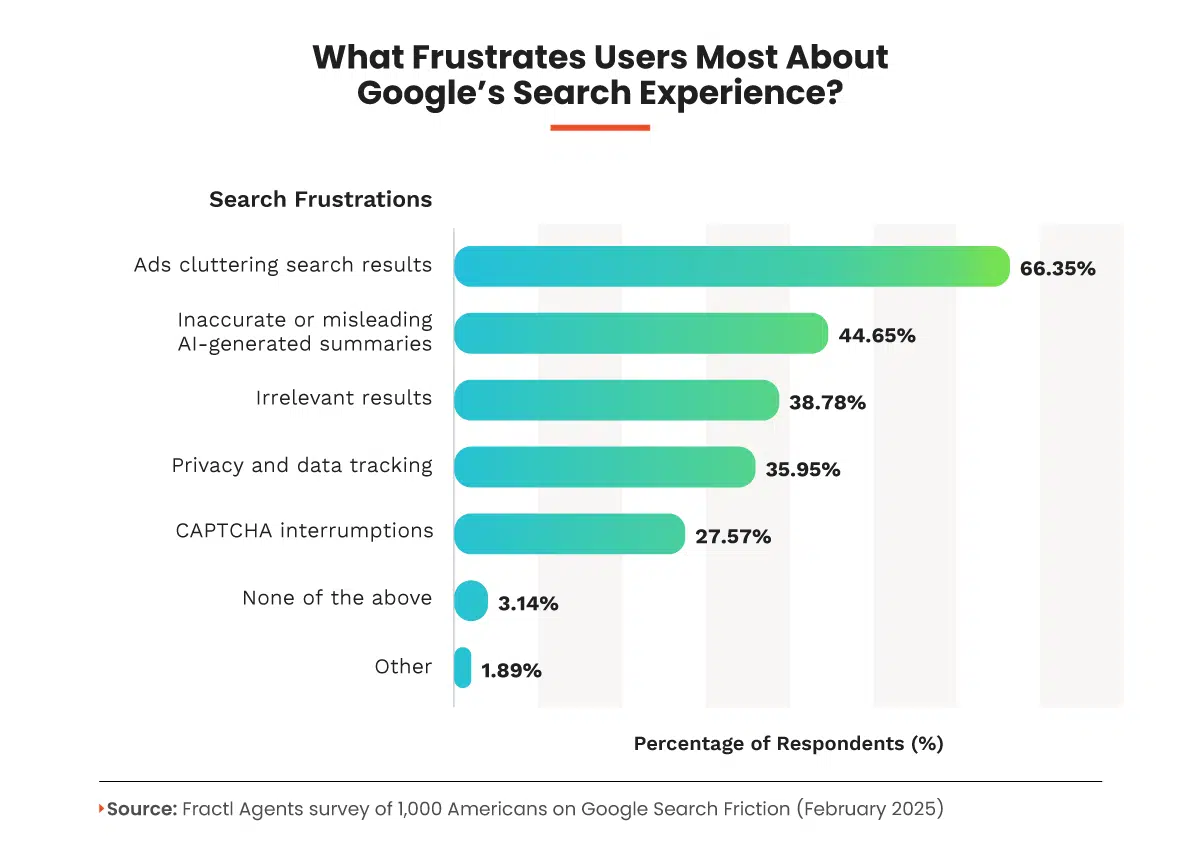
Consumers aren’t abandoning Google for lack of quality content; they’re escaping SERP friction for clean interface design and faster answers.
When ads bury answers, clean interfaces reign supreme, and AI tools deliver. At least, they’re ad-free , for now.
That’s why even as Google gets 5 trillion searches per year (with 20% YoY growth ), tools like ChatGPT are already ranking as the 5th most visited site globally , with nearly 5 billion visits per month.

2. 64% feel positive about AI, 74% feel confident using AI tools
Think consumers aren’t AI savvy? Think again.
When it comes to the technology adoption lifecycle , we’re officially entering the Early Majority phase.
After ChatGPT’s explosive growth, 100 million users just two months post-launch and over 200 million registered by Q1 2025, we’re seeing:
- Major SaaS platforms (Microsoft 365, Salesforce, Slack) bake generative-AI features into everyday workflows.
- Mid-market and large enterprises piloting (and increasingly licensing) ChatGPT for content.
- ChatGPT itself achieving household-name status.
This signals that AI has crossed the chasm and is rapidly becoming a go-to search platform for everyday consumers.

It’s no longer a matter of if this technology will go mainstream – it has.
Only 8% of respondents weren’t familiar with ChatGPT or Gemini, and 47% said they would explore AI tools as soon as they launch.
It’s no wonder why, with 59% of people believing AI will improve the quality of their life and only 33% thinking “AI is overhyped.”
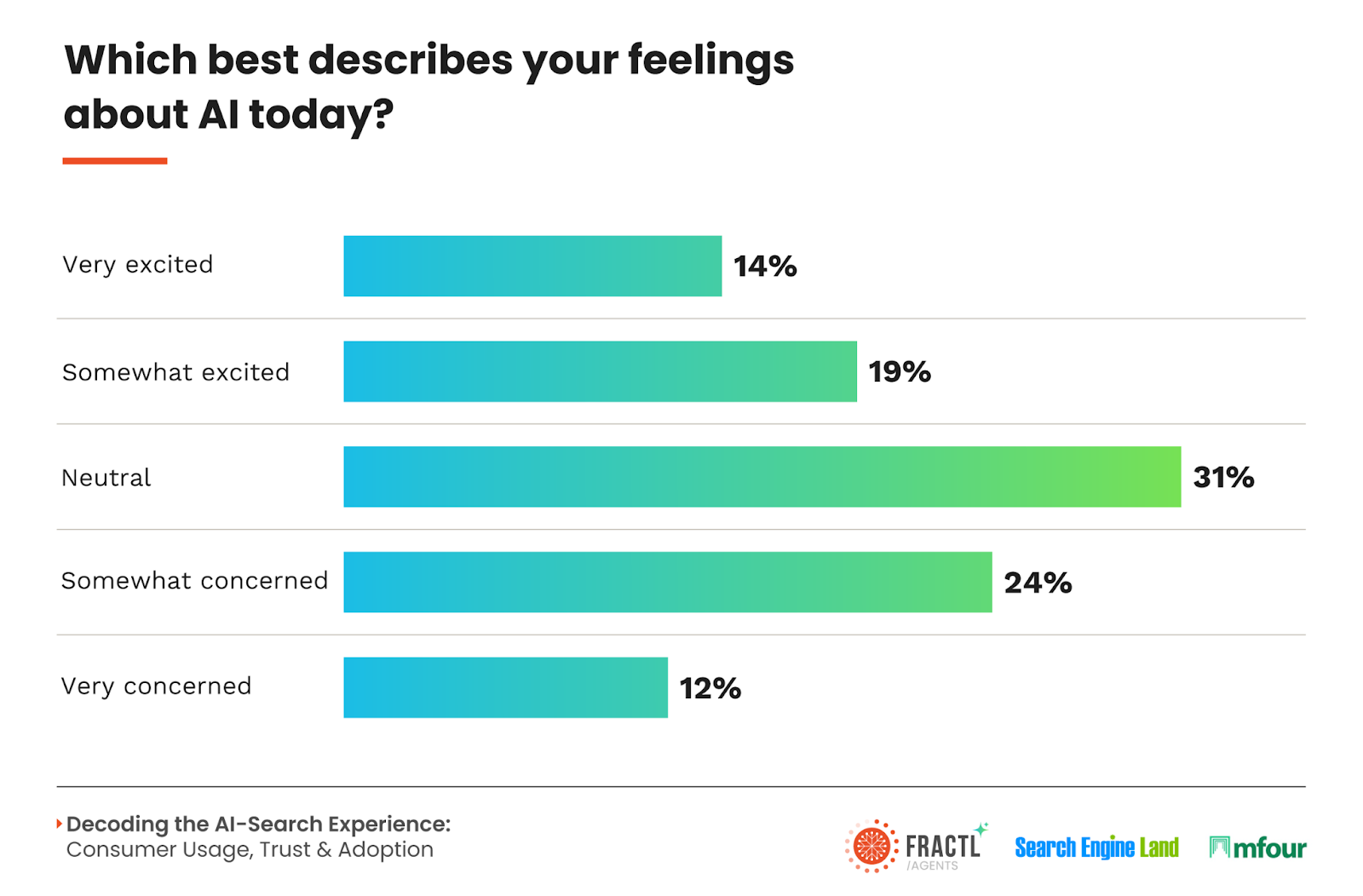
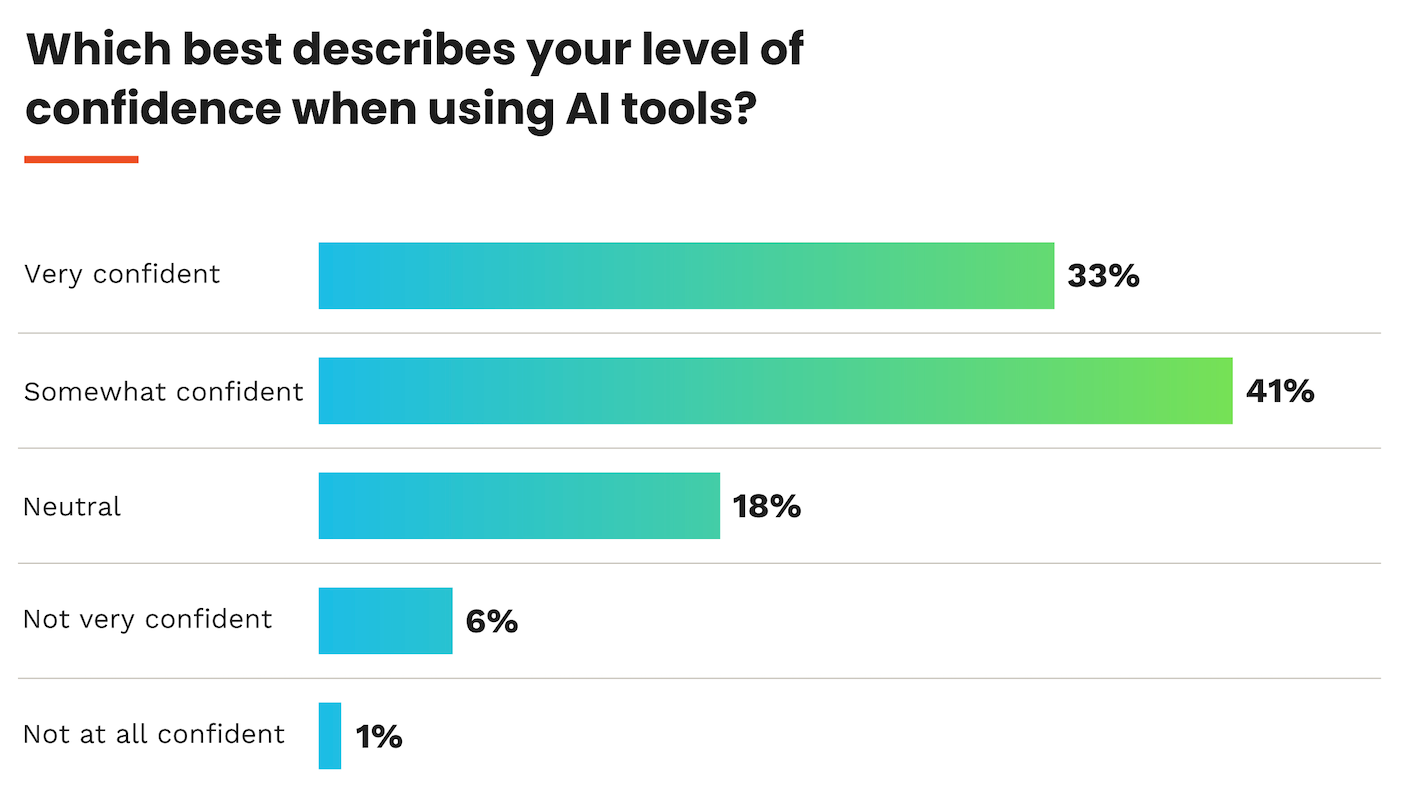
3. 82% find AI-powered search more helpful than traditional SERPs
Yet, only ~ 22% of marketers track LLM brand visibility or traffic.
Google Search (77%), LLMs (49%), and AI Overviews (38%) top the charts as preferred consumer search tools.
But with 82% of respondents agreeing that “AI-powered search is more helpful than traditional search engines,” it’s clear how consumer search will evolve in the near future.
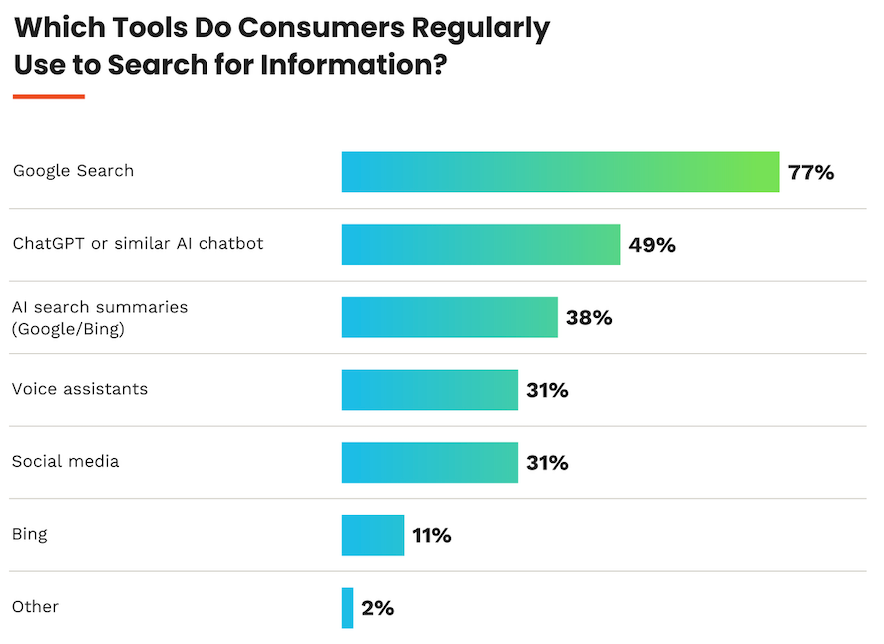
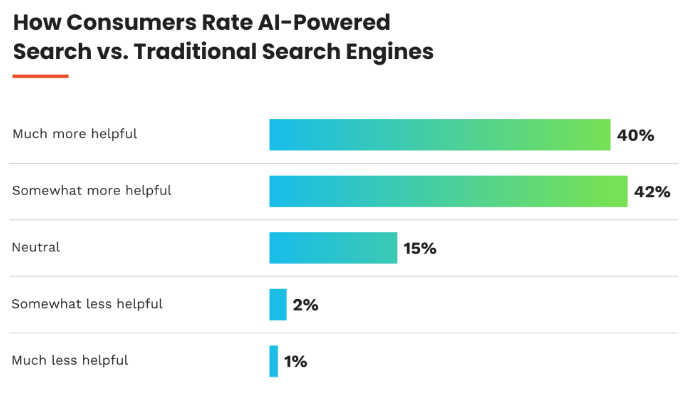
Although consumer search behavior is rapidly evolving, marketing executives haven’t quite caught up.
Only 22% of marketers have set up LLM brand visibility or traffic monitoring.
At least marketers recognize the urgency, with 53% saying they’re in the early stages of exploring how to monitor this emerging brand channel.
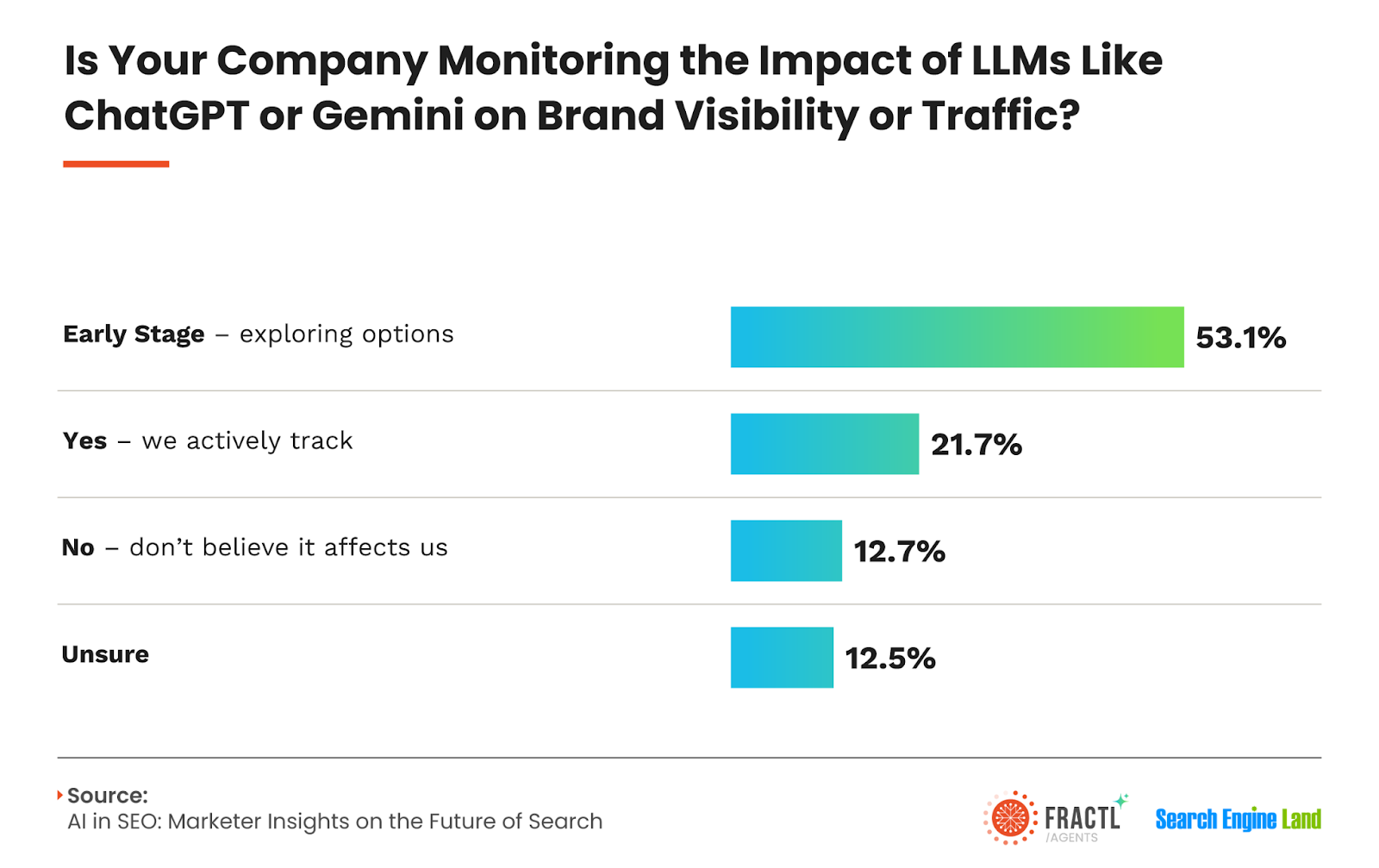
4. 78% of marketers and 68% of consumers are concerned about AI-driven misinformation, more than the fear of job loss
It’s not all sunshine and daisies in the world of AI innovation.
Hallucinations and misinformation are legitimate concerns for consumers and marketers alike.
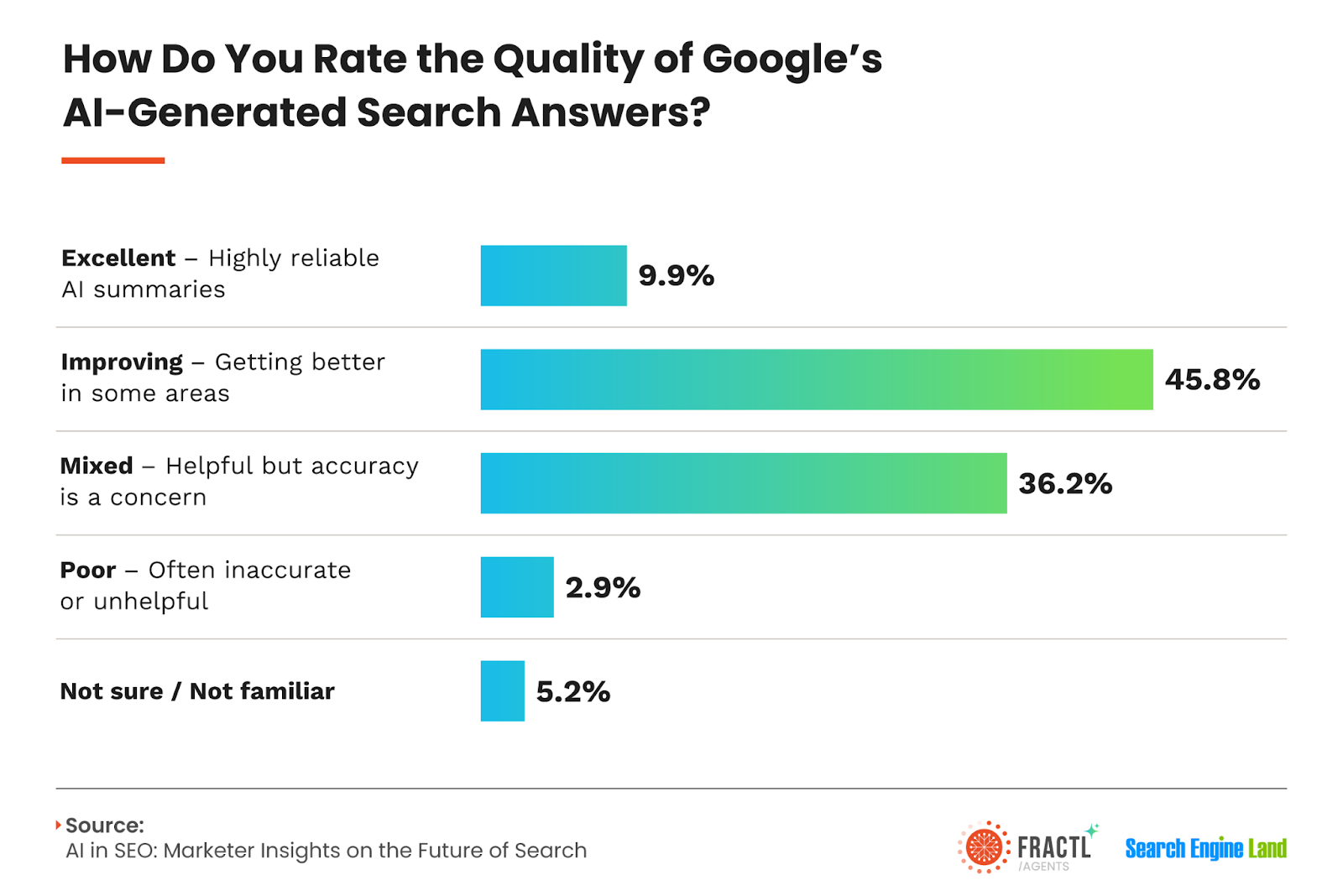

Over the next 12–18 months, “search” will increasingly feel like a dialogue with a model.
Worried about hallucinations?
It’s a short-term problem due to premature rollouts, but ultimately:
- Google’s AI Overviews is built to cite sources.
- Bing Chat taps real-time crawling to cut down on made-up answers.
Those safeguards aren’t flawless (yet), but transformer architectures, retrieval-augmented generation, and other core technologies are improving exponentially.
In 6-12 months, blatant hallucinations should be much rarer, and AI responses will include the trustworthy brand citations we’re all after.
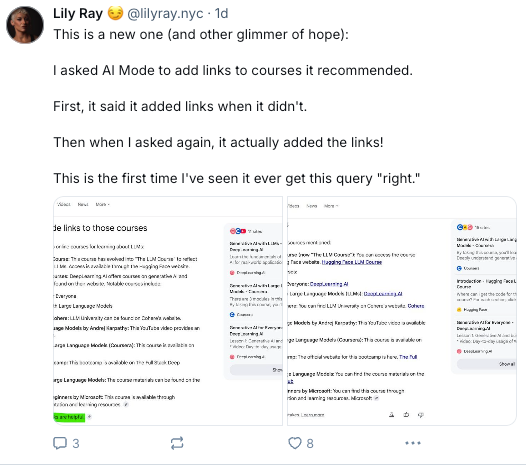
Still, it’s imperative that we address consumer concerns around the potential impacts of AI, especially regarding misinformation.
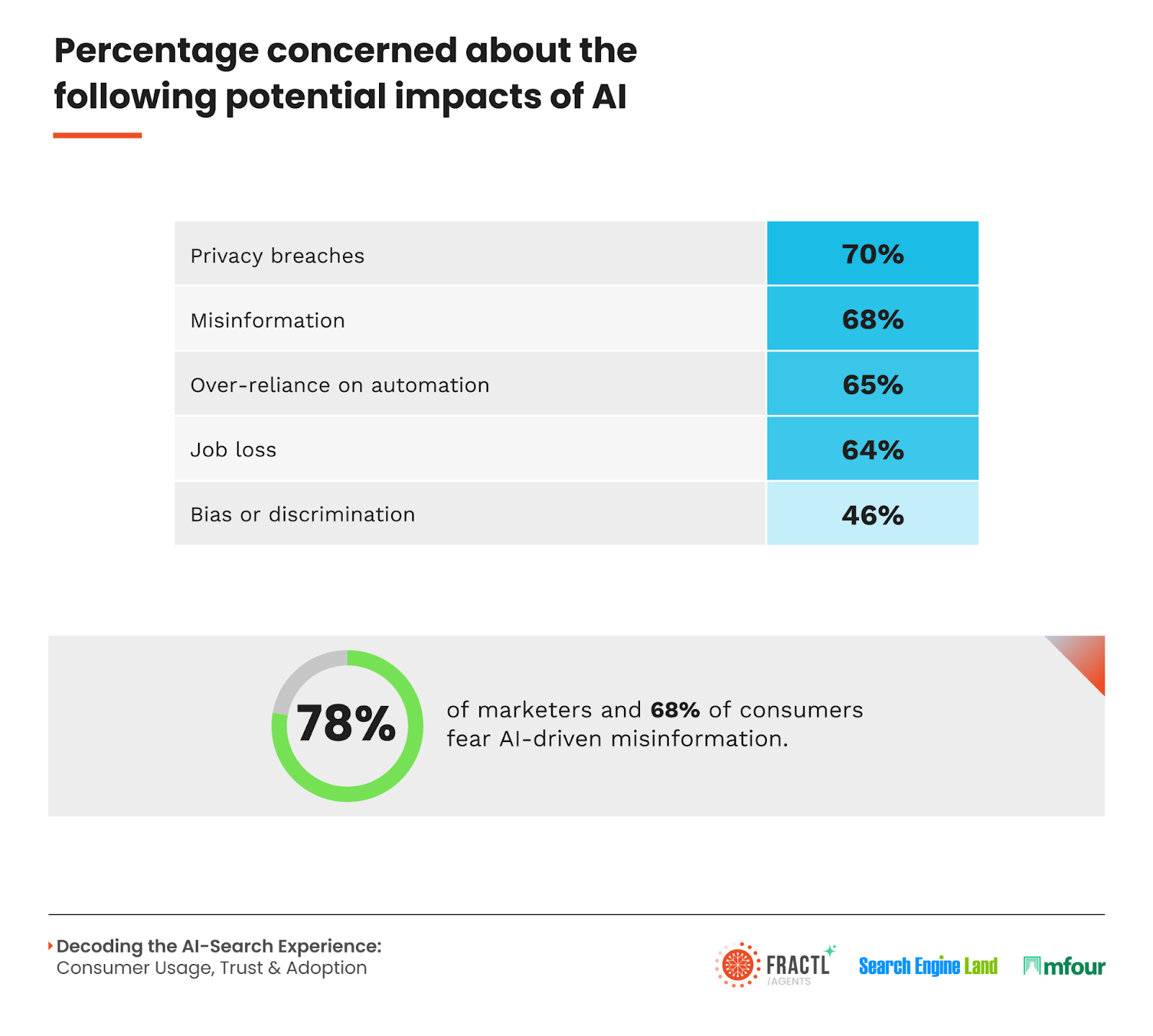
To fight misinformation in AI-driven content workflows, marketers need to double down on:
- Proprietary source of truth.
- Source transparency.
- Credible author review on E-E-A-T topics.
- Bias and fact-checking.
- Robust author bios.
Proprietary “sources of truth” are one of the best ways for you to produce unique, high-value content with robust, accurate data.
This means giving your AI workflow direct access to proprietary datasets or information, whether that’s:
- A knowledge base (i.e., training guides, brand guides).
- A data feed (i.e., brand research, an API).
With this, every AI-generated statement can be produced and cross-checked against factual information.
By feeding AI models proprietary sources of truth, you eliminate guesswork and significantly reduce hallucinations.
For instance, my company creates proprietary brand research enriched with insights from client SMEs, designed to earn newsworthy coverage and authoritative mentions.
Every step of that process, from research to digital PR, is enhanced by agentic workflows and custom GPTs.
These AI tools handle the tedious parts, drawing on a decade of training materials, proprietary data, and client guides as their source of truth.
This streamlines content production and digital PR, while reassuring stakeholders that every AI-driven workflow is grounded in proven industry best practices.
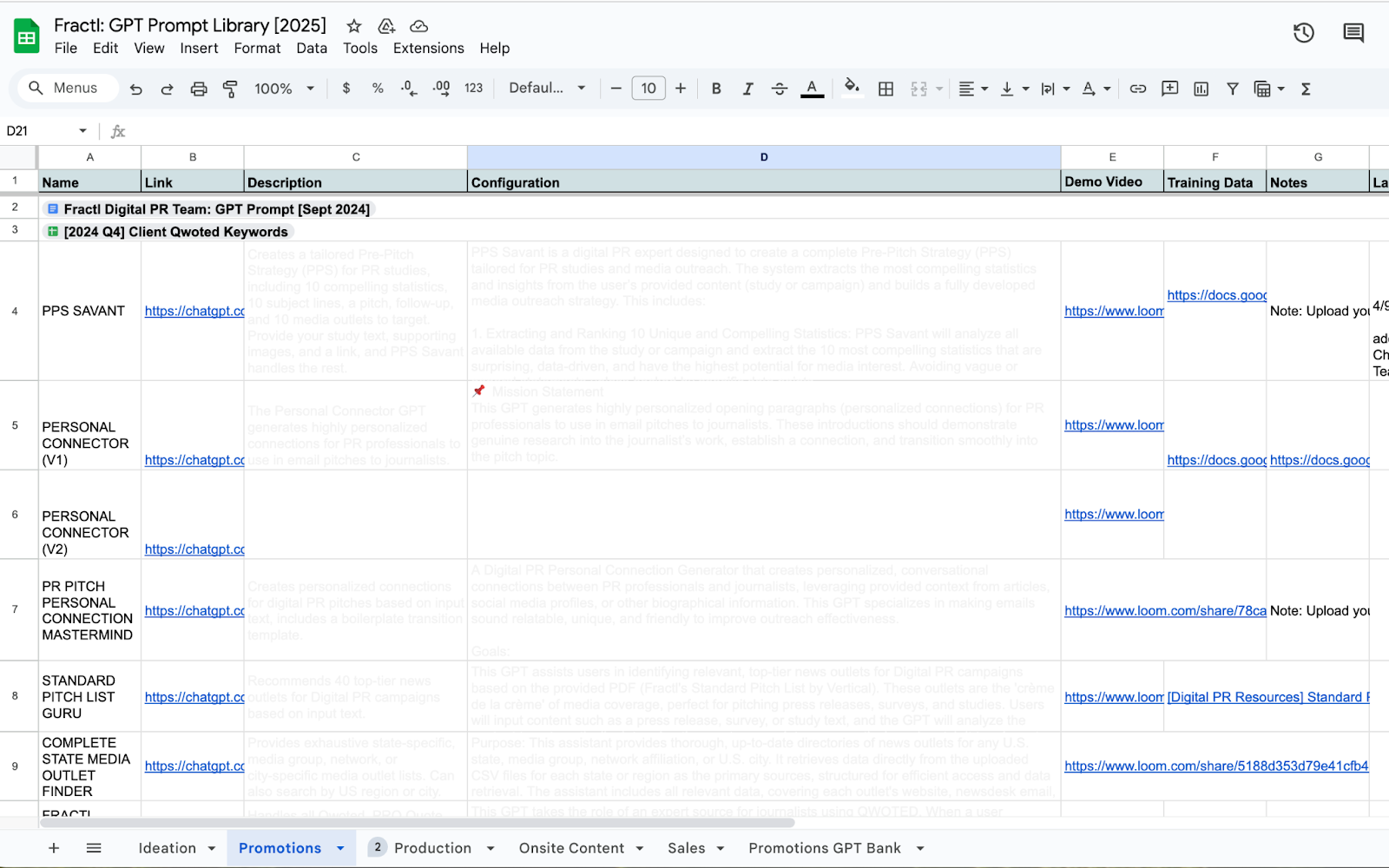
Source transparency and credible author review on E-E-A-T topics (or really, all topics) are other critical steps for establishing brand credibility.
All of our clients are encouraged to build authoritative author profiles for SMEs so consumers (and ranking algorithms) have clear source transparency and an immediate understanding of the educated stakeholders who were involved in publishing the content.
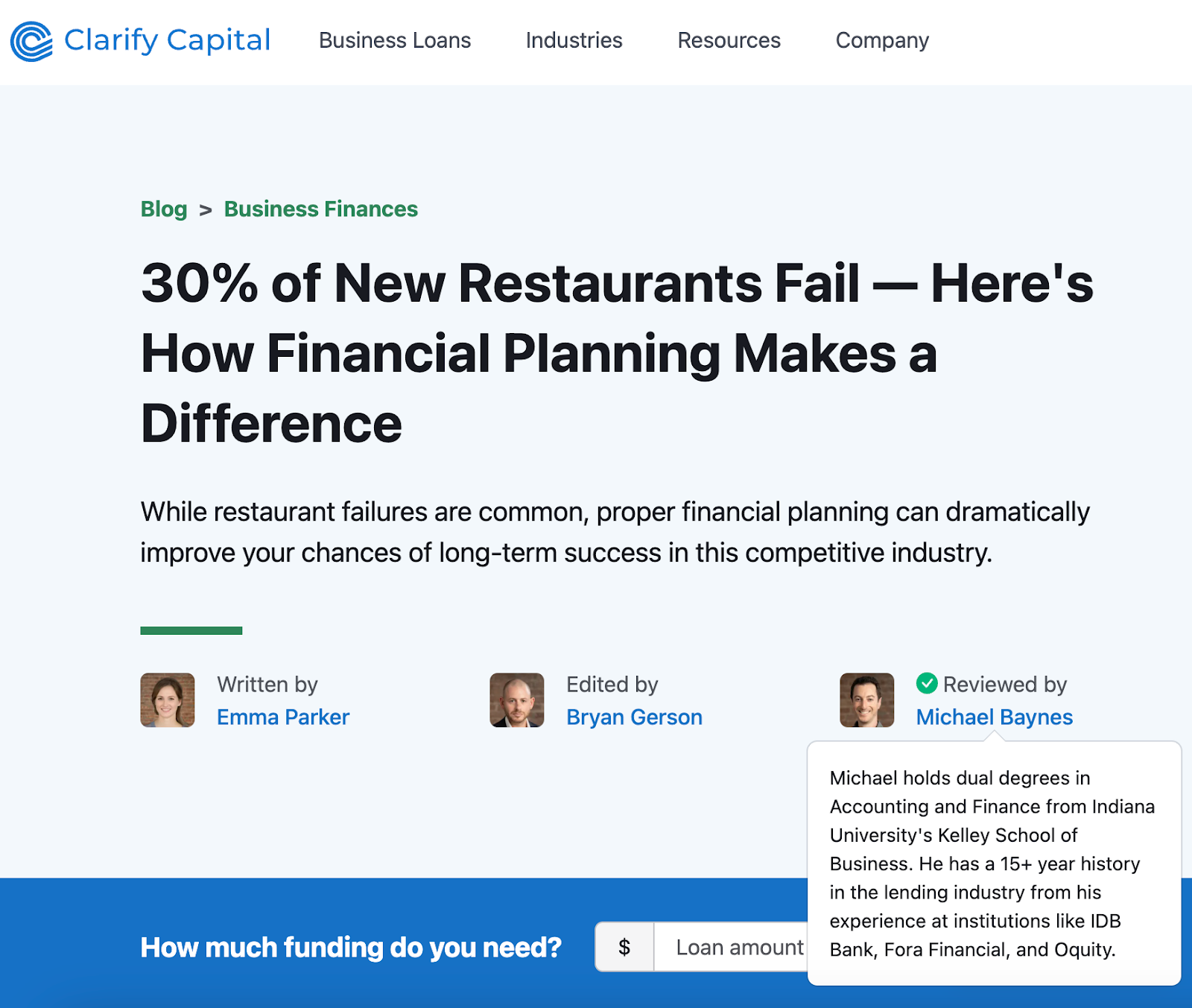
Beyond that, AI-driven content should be audited for bias and inaccuracies, especially if you aren’t using a proprietary source of truth.
While there should always be a “human-in-the-loop” in AI workflows, even humans have these same fallacies.
That’s what agentic workflows can be ideal for doing scaled audits of bias and fact-checking.
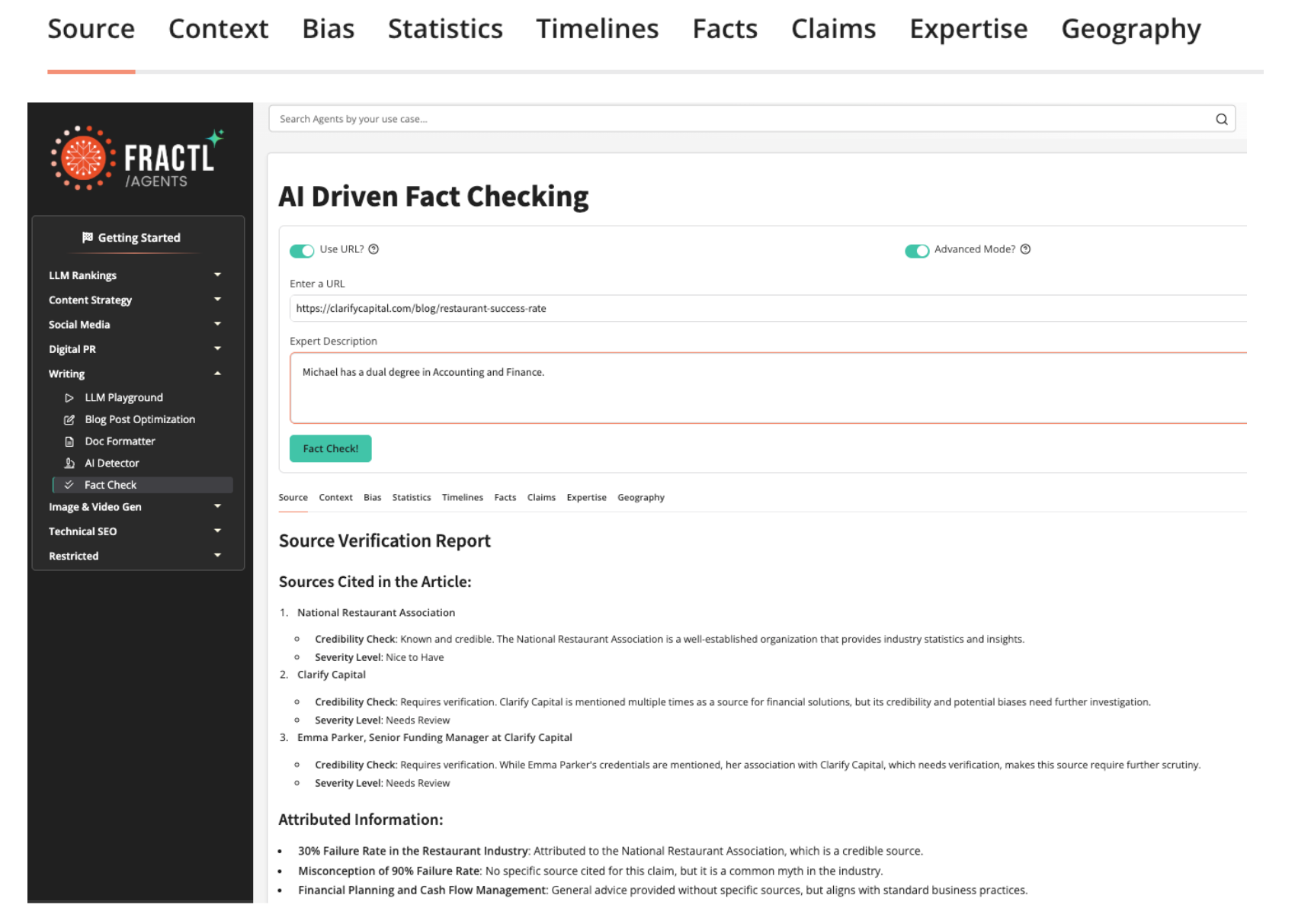
5. 80% of consumers have a neutral or positive attitude toward trusting brands that use AI-generated content, only 20% don’t
While AI Overviews have driven high levels of skepticism in the SEO industry, the broader consumer market is open to trusting AI-generated content.
Especially when brands follow the guidelines outlined above.

6. Only 11% of marketers feel ‘over-reliant’ on AI tools, yet over 50% of feel ‘high pressure’ to adopt AI to stay competitive
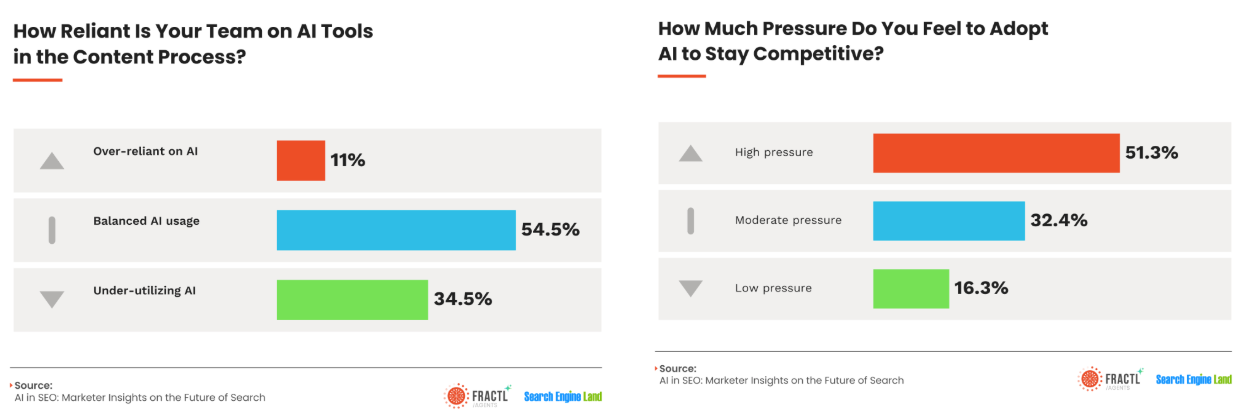
When half your industry feels pressure to adopt something, but only 11% worry they’re overdoing it, you’re looking at classic early-majority anxiety – not actual overreliance.
Marketers who feel “high pressure” to adopt AI are typically part of:
- The 30% struggling to keep up with the pace of AI advancements.
- The 29% that fear job security due to AI automation.
- The 15% who lack internal resources to implement AI effectively.
Still, the only way to keep AI from taking your job, is to use AI to do your job better.
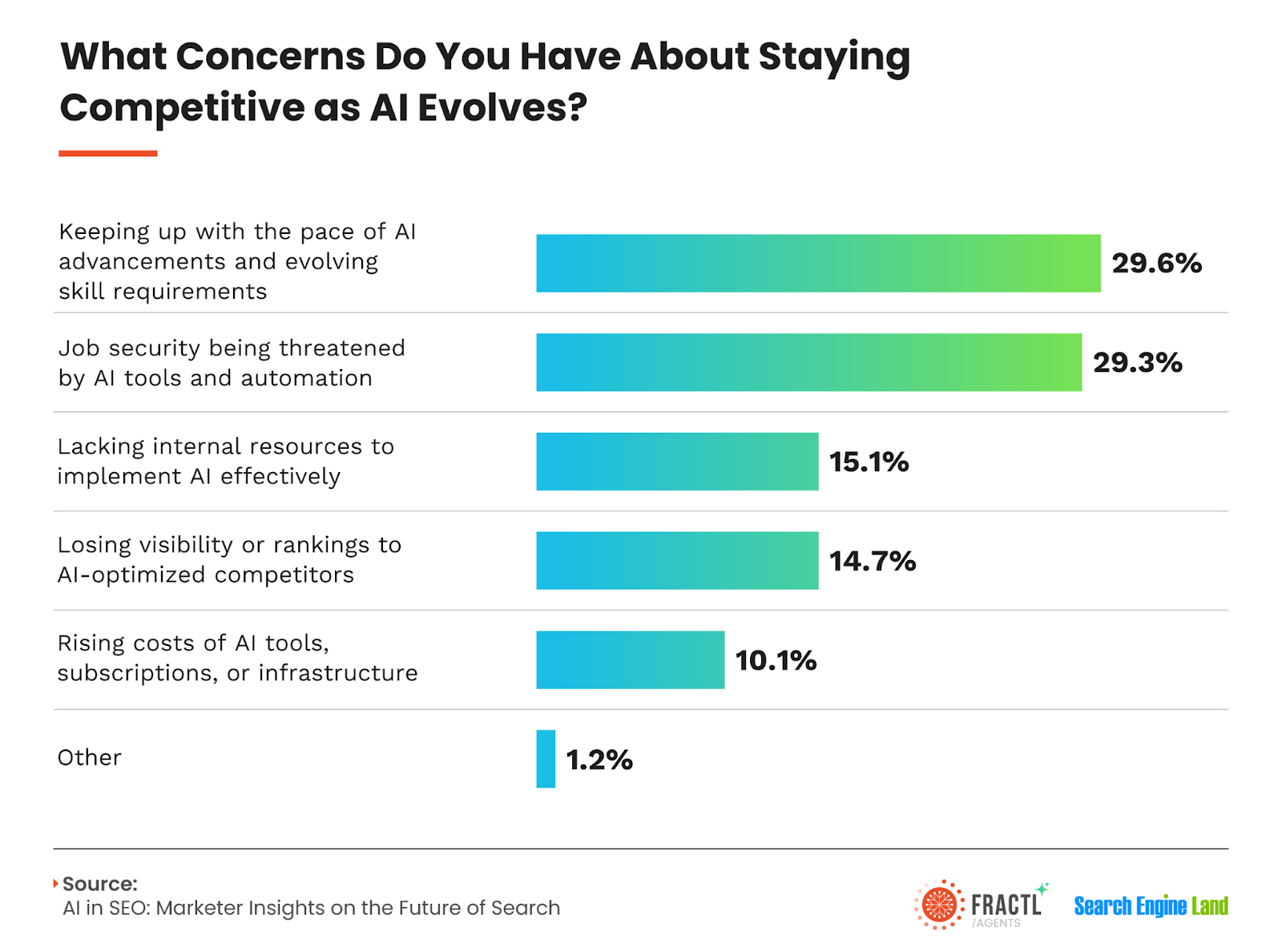
If these fears exist within your organization, you have a cultural enablement problem, and it’s time to get proactive before cultural sentiment and brand visibility suffer:
- Adopt a companywide growth mindset.
- Promote internal champions to pioneer AI innovation in each department, focusing on custom GPTs, prompt libraries, and agentic workflows.
- Launch quarterly AI upskilling sprints to keep your team ahead of the curve.
The pressure will only increase as adoption hits mainstream, but the advantage goes to teams that integrate thoughtfully, not frantically.
7. 74% of marketers are using AI tools in some part of their workflow
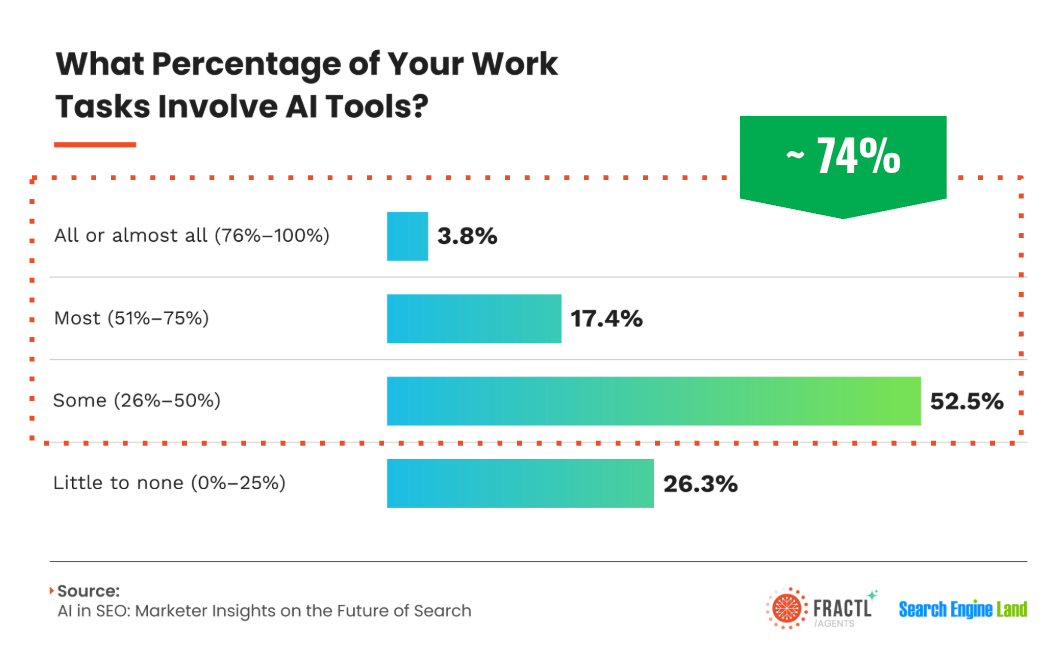
74% of marketers are using AI tools in some part of their workflow, but only 4% rely on it for more than three-quarters of their work.
The data reveals where marketers are finding the most value:
- 44% use AI for social content.
- 43% for SEO analysis
- 40% for data reports.
On the other hand:
- In-house teams lean heavily on social drafting (45%).
- Agencies focus on SEO optimization and analytics (44%).
- Consultants prioritize keyword research (48%).
The pattern? AI’s winning at high-volume, low-creativity tasks.
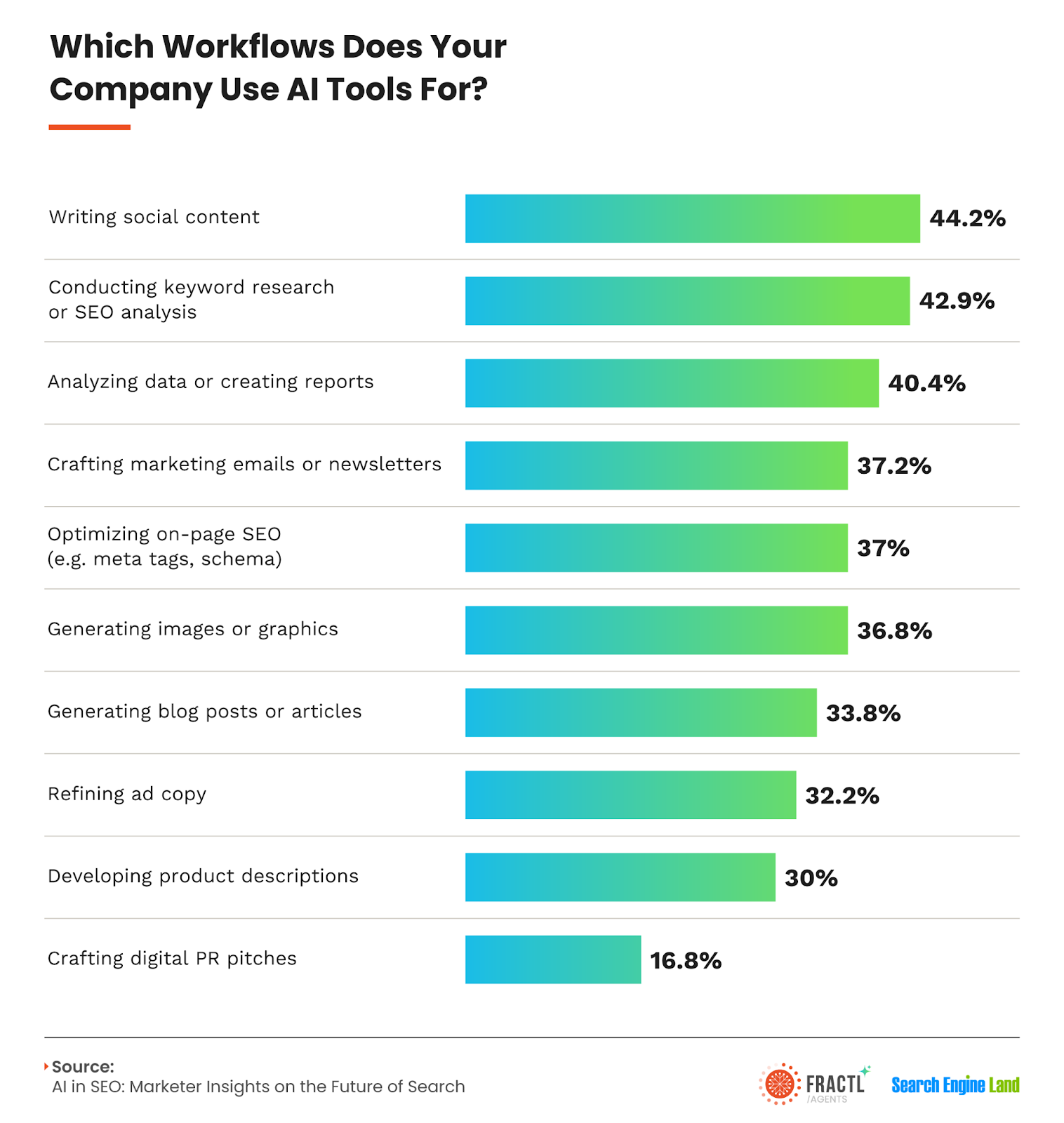
The biggest surprise in our research?
SEO penalties from AI content barely register as a concern among marketers, but misinformation anxiety is through the roof.
The assumption is that Google will penalize AI-generated content.
The reality?
Google’s more likely to reward AI content that demonstrates originality, depth, and clarity than punish content simply because it was AI-assisted.
It’s time to shift your concern from “will AI hurt rankings?” to “will AI content deserve rankings?”
Here’s the operational framework that works:
- Use proprietary sources of truth to combat misinformation risks.
- Demand editorial fact-checking before anything ships.
- Design writing prompts that prioritize divergent thinking over generic tone – because creativity still matters, a lot.
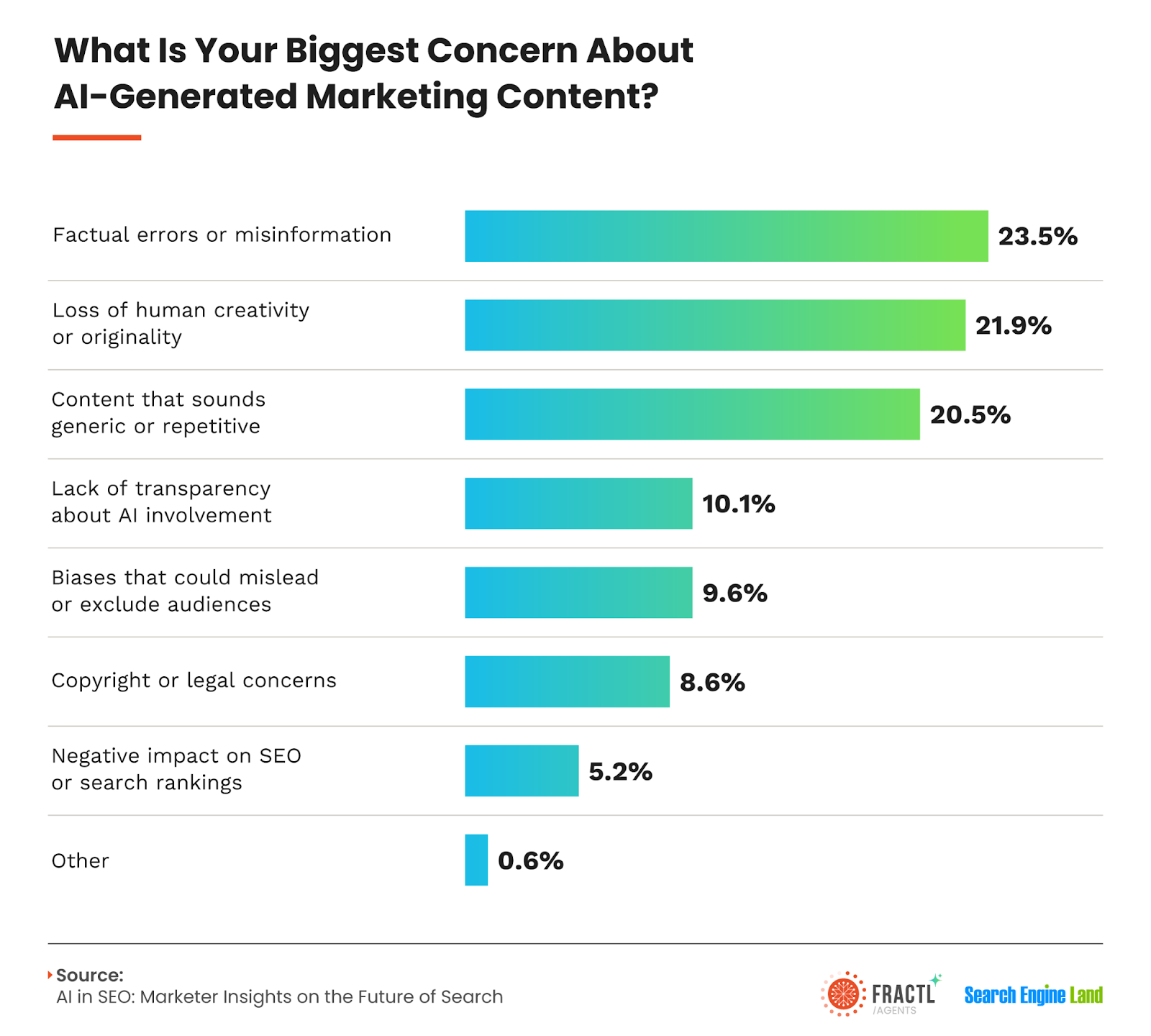
The guardrails matter:
- Use proprietary sources of truth to combat misinformation anxiety.
- Design prompts that prioritize divergent thinking over generic tone.
- Shift concern from “will AI hurt rankings?” to “will AI content deserve rankings?”
Teams don’t need to fear AI, they need to fear mediocre brand content in a sea of sameness.
8. 93% of marketers say AI tools are saving them time each week, but only 19% reinvest it in professional development
The assumption is that AI adoption equals productivity gains, but the time paradox reveals the deeper problem:
- 93% of marketers say AI tools are saving them time each week.
- But only 19% reinvest it in professional development.
Most? They just produce more.
That’s not optimization, that’s just faster hamster wheels.
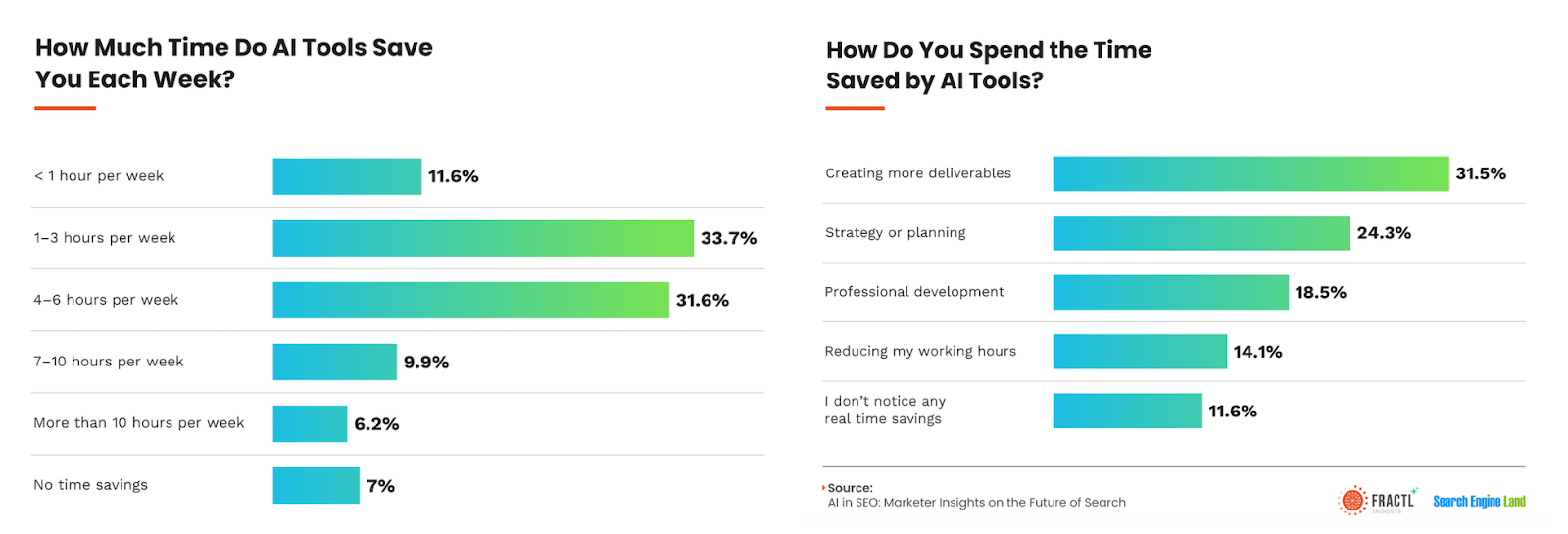
Across the industry, teams that treat AI as a volume multiplier burn out faster than teams that treat it as a capability amplifier.
As an example, my team drives 70% human strategy, creativity, and relationship building and 30% AI execution, research, and optimization.
We expect this ratio to shift to 60/40 by 2027, but the human elements will become more valuable, not less.
As a result of our AI efficiency gains over the last two years, we started piloting a four-day workweek in 2023.
As a result, our company culture, client retention, and department KPIs are stronger than ever.
The lesson for management?
Build AI usage into your org’s KPIs, appoint internal champions, create learning paths, and reward and recharge your team with the time saved.
9. Search isn’t a platform – it’s a behavior that’s fracturing across interfaces
SEO is no longer about gaming keywords; it’s about earning authority that algorithms recognize universally.
Let’s all take a deep breath and remind ourselves: content marketing is an advanced skillset that has driven visibility across most of the platforms that emerged over the last decade.
After all, the most effective SEOs have always focused on producing fresh, educational, data-driven content, which:
- Drives qualified brand traffic and engagement.
- Builds authority.
- Achieves cross-channel brand visibility.
Today, these strategies have all been proven to elevate brand visibility in organic SERPs, LLMs, SGEs, and AI Overviews.
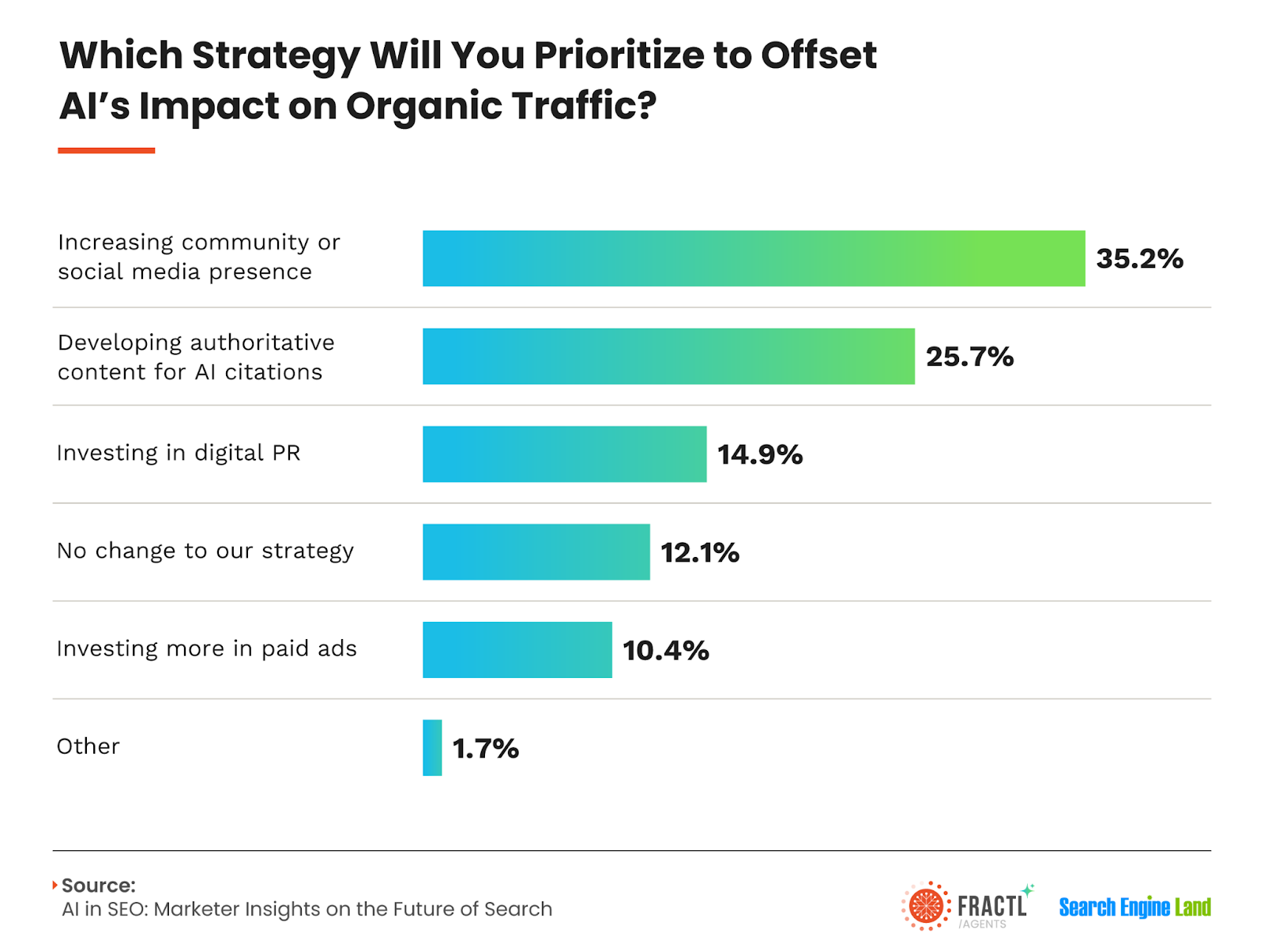
We’re not watching the death of search.
We’re watching the convergence of channels – search, social, AI – all optimized by the same core signals:
- Authority (citations and mentions).
- Originality (first-party research and insights).
- Trust (consistency across platforms and personas).
Digital PR and brand visibility are now essential LLM inputs.
The same tactics that earn coverage, backlinks, and social engagement also improve your odds in AI summaries and SERP overviews.
If you can master this convergence, you’ll win on Google, ChatGPT, TikTok, and whatever fractures emerge next.
Remember : the fractures aren’t the problem, they’re the opportunity.
But only if you stop treating them like separate games and start building the credibility that works across all of them.
Methodology : We surveyed 2,302 U.S. adults and 810 marketers in May 2025 to explore how attitudes and behaviors around AI vary across consumers and marketing professionals. Marketer responses were drawn from a balanced sample, ensuring all referenced subgroups comprised at least 10% of the total sample.
